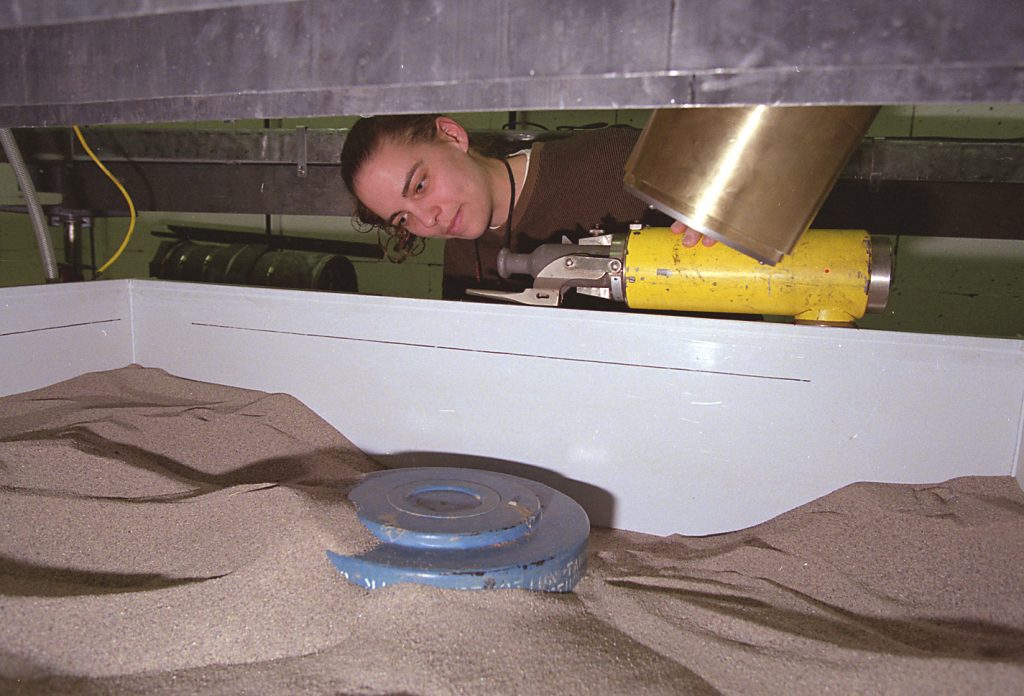
(Photo by Randy Montoya)
Download 300dpi JPEG image, ‘Lockwood.jpg’, 1.6Mb
ALBUQUERQUE, N.M. — You come upon an unfamiliar briefcase leaning against a wall in the building in which you work. Or maybe it’s sitting on a chair that shouldn’t have a briefcase on it. If no one claims it, you might be tempted to open the latch to see to whom it belongs and return it.
But if the thought occurs that, just maybe, this could be a bomb set by a crank or terrorist, how would you find out without blowing yourself up?
Police see inside packages like dentists examine teeth: An X-ray beam creates an image on film placed behind the object. But who wants to volunteer his hand, face, or life to place film behind a leaning package?
Because few people do, police evacuate buildings and then detonate suspicious packages — a necessary though sometimes pointless practice that causes alarm, physical damage, and lost working hours.
Now a portable machine, built at the Department of Energy’s (DOE) Sandia National Laboratories and still in the laboratory stage, offers a different way to see what’s in the package: through use of reflected, rather than transmitted, X-rays.
The technique evolved from more powerful machines developed by Sandia to use reflected X-rays to detect plastic or metal landmines buried in the ground — to make sense of images reflected from random locations where no possibility exists to conveniently place film.
Using lighter, less powerful, off-the-shelf equipment, Sandia researchers find they can use a similar technique to evaluate what’s inside a nearby box. Reflected X-rays, if intense enough, can form an image of the object reflecting them. A special filament heated by wall-current electricity releases electrons with sufficient energies in the X-ray range.
“I’d like every law enforcement body to have one of these,” says Sandia project manager Steve Shope. “We’d like to get the price down where every law enforcement agency can afford one, and I know their limited budgets.” The price of the unit for police departments is contingent on further research, development, and manufacture.
Commercialization could be achieved in two years, says Shope. Representatives from the US Department of Alcohol, Tobacco and Firearms have expressed interest.
The DOE and US Department of Defense signed a memorandum of understanding to develop the landmine detection technique. Current research is funded by Sandia’s Laboratory-Directed Research and Development program, which funds speculative, defense-related research.

(Photo by Randy Montoya)
Download 300dpi JPEG image, ‘buried.jpg’, 1.8Mb
Distinguishes between explosives, bologna, or shaving cream can
A clever computer program, developed at the University of Florida at Gainesville under contract with the US Army, can distinguish between degrees of reflection (back-scatter) caused by objects in the case.
By stripping layer after layer in a series of X-rays — a similar technique to a CAT-scan — the changes in backscattered X-rays form a complete picture.
“We can tell if it’s explosives, bologna, or a can of shaving cream,” says Shope.
For effective police work, the detector and video camera will be placed on a mobile robotic platform that rolls down hallways while its operator stays safely out of range, observing the surrogate’s progress through real-time video images sent back by a trailing cable.
The system will ride on a mobile cart about four feet high. “It’ll be that small to easily fit on an elevator,” says Grant Lockwood, principal investigator on the project.
Even if the suspicious device explodes before transmitting a complete image, partial images useful in police work have already been transmitted back to the operator. And all that is lost is the video camera, X-ray machine, and cart, rather than lives.
Another reason for the newer method, says Lockwood, is that “if I place film behind the device and it goes off, I have no record.”
He first presented the technique last November in Boston, at the International Society for Optical Engineers (SPIE) conference, under the title, “Enabling Technologies for Law Enforcement.”
One limitation of the current device is that it must repeatedly scan an object to build up an image, a process that takes about 40 minutes. A newer method, currently funded and under development, uses a snapshot approach expected to be much faster.
Could detect weakened rebar, long-lost electric lines
Future possibilities include creating a more powerful rolling device to locate metal reinforcements (rebar) in the basement walls of old buildings, scanning bridges to detect weakened rebar before it collapses, and finding electric lines buried long ago in older cities.
“There are so many things buried in the ground of older cities that, in many cases, engineers don’t know where their own electric lines are located,” says Lockwood.
Other researchers involved in the project are Joseph Wehlburg, Michael Selph, and Jennifer Jacobs.
Sandia is a multiprogram DOE laboratory, operated by a subsidiary of Lockheed Martin Corp. With main facilities in Albuquerque, N.M., and Livermore, Calif., Sandia has major research and development responsibilities in national security, energy, and environmental technologies and economic competitiveness.